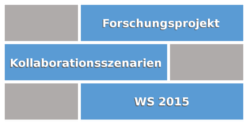The first step of classifying a case study consists of determining key data elements of a case study. Belonging to these key data elements are for example the year of publication and the year of going-live, the size and industry of a company, deployed software and a brief summary. They are used for the filter functionality of the catalogue and can be accessed at the overview page of the classified case studies, see Resources.
In order to identify and classify collaboration scenarios those paragraphs of a case study are relevant that describe the practical use of Enterprise Collaboration Systems within the respective companies. The students of the research project applied two different classification strategies: A top-down strategy and a bottom-up strategy. The article Theoretical Background and Models may aid in better understanding these two strategies.
Top-Down Strategy
In the top-down strategy a use-case will be determined first in a given case study. For this use-case all related collaboration scenarios that are contained in the use-case will be classified. Collaboration scenarios can be divided in different activities that are performed with diverse collaborative features. Thus the set of activities and associated collaborative features that belongs to a collaboration scenario will be identified at last. The top-down strategy will be continued until for all use-cases that are mentioned in a case study the related collaboration scenarios are classified.
Bottom-Up Strategy
The bottom-up strategy is the reverse approach of the top-down strategy. It starts by determining the collaborative features that are mentioned in a case study. Then the activities that are performed with the help of the collaborative features will be identified. The pairs of activities and collaborative features are assigned to one or possibly many collaboration scenarios, depending on the context of the activities. Finally for each collaboration scenario a set of use-cases is determined that contain the respective collaboration scenario.
Implicit activities and explicitly mentioned activities
In the case studies some activities that are performed with the support of collaborative features are explicitly mentioned. Those explicitly mentioned activities are part of the data basis for the catalogue. The occurrence of other activities can often be assumed, yet these activites are not explicitly mentioned in the case study. These activities are called implicit activities by us. They have not been considered in the catalogue.
Data Basis
The basis for classification are given by the Enterprise 2.0 case studies. They are documented on the homepage www.e20cases.org . This platform is directed at student, as well as at scientist and lecturer. The team around the platform exists of university institutes who deal with the application of Social software in enterprise. Part of the team among others are the University of Koblenz-Landau, the University of Munich and the University of St. Gallen.
The Enterprise 2. 0 case study networks distinguishes the case studies in four categories: Orange, gold silver and bronze. These differentiate levels of detail with the case study descriptions.
For the classification, case studies from all categories were chosen. All these case studies document the application of Social software in enterprise. The case studies can be screened in different categories, for example branch, year, enterprise size or Use Case. Thereby you can find the case studies which are relevant for the respective use.


